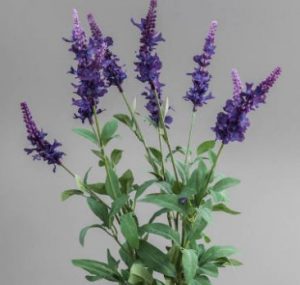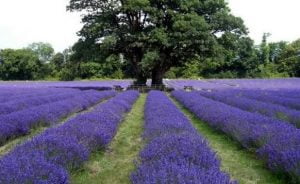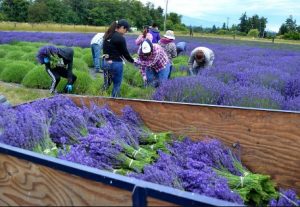Lavender is grown as a cash crop. Its plant is considered useful in many ways. The flowers that bloom on its trees are used for everything from decoration to food. Its flowers are used in food to flavor a wide variety of foods and desserts. Its flowers have a sweet taste. It is also used to enhance sweetness.
Oil is also found in lavender plants. Used in food as well as in soaps, perfumes and cosmetics. Apart from this, this plant is also used to prevent many diseases. The flowers are dark black, blue, red and purple. The seedlings are found to be two to three feet in height.
Lavender is grown mainly in the Mediterranean region. By the way, its origin is considered to be the continent of Asia. Cold weather is suitable for its cultivation. The leaves of this tree are narrow. High heat is not considered suitable for its cultivation. The winter season is perfect for its cultivation. The pH of the soil for its cultivation. The value should be normal.
If you are also thinking of planting lavender, today we will give you complete information about its cultivation.
Suitable soil
Lavender cultivation requires well drained soil rich in organic matter. The roots of his tree are able to go deep. As a result, it can grow easily in any type of soil, whether hilly, flat or sandy. The pH of the soil for its cultivation. Value must be between 7 and 8. In light alkaline soils, the oil content is higher in the plants.
Climate and temperature
Both climate and temperature play a major role in the cultivation of lavender. Lavender is considered to be the predominant plant in the Mediterranean climate. Cold weather is required for its seedlings to grow. Therefore, in India, it is grown mainly in the foothills of the Himalayas where the climate is pleasant even during the summer season. For its cultivation, space with air is required. Its seedlings cannot grow in harsh summers and die soon. Its cultivation does not require much rain.
Its seeds and seedlings require a temperature of 12 to 15 degrees for early germination. After that the seedlings need a temperature of about 20 to 22 degrees for growth. Lavender trees can withstand a maximum temperature of around 25 to 30 degrees. They thrive even at a minimum temperature of around 10 degrees.
Improved varieties
There are several improved varieties of lavender available in the market. Which have been developed based on plant height and flower color and production. These species are divided into three species based on the size of the plants.
Dwarf plant
Hydcoat Superior
The height of this type of dwarf species is 40 to 45 cm. Occurs in between. Its flowers are black, purple and blue. The oil content of this variety is 0.8%. About 50 kg of oil is produced per hectare of this plant.
Fasting
Plants of this species can grow up to 40 cm in height. The flowers of this species are found in pink color. About 40 to 50 kg of oil is produced per hectare of this plant.
Lady Lavender
The branches of this type of plant spread less and grow upwards. The plants of this species are found to be about one and half feet in length. Blue flowers are found on this type of plant. Trees of this species are known to give uniform yield from the first year.
Trees of medium height
Folgate
Plants of this species of medium species keep very good quality only at the time of first harvest. Its flowers look blue. Its trees are about two feet high. The oil content is about 60 kg.
Beachwood blue

This species of lavender is found at a height of one and a half to two feet. Flowers per hectare are found to be high from this species. Therefore, the amount of oil produced from them is higher than that of many other species. The flowers of this type of plant look violet blue.
buene vista
Two colored flowers are found on this species of plant. Whose production is also very high. Plants of this species grow to a height of 50 to 60 cm.
Long length
Dawn a Kashmir lavender
Plants of this species are found to be more than two feet in height. Blue flowers are found on this type of plant. The amount of oil available is higher than that of other varieties. The average oil content of this species is about 80 kg.
Melissa Lilac
Plants of this species are more suitable for medicinal properties. Its length is about 60 to 75 cm. The flowers of this species are light red in color. Whose size is too large.
Apart from this, there are many other varieties which have been developed for higher production in different places. These include Cajan Look, AM1, Hems, Airama, Carlovo, Sweatzest and Vanettes.
Farm preparation
Once planted, lavender yields for many years. Therefore, good preparation is required at the beginning of the field. For planting fragrant flowering plants, initially, destroy the remnants of old crops in the field and deep plow with soil-reversing plow. Then leave the field for a few days to get intense sunlight. After clearing the field, old manure should be dumped in the field and mixed well in the soil. After fertilizer is mixed in the soil, it should be watered in the field.
After plowing, when the topsoil appears slightly dry, plow the field with a cultivator and run a rotavator in it. As a result, the soil in the field looks humid. After running the rotavator in the field, level the field by tapping into it. So that water will not accumulate in the field during monsoon.
Transplanting seedlings
Lavender can be grown from both seeds and plants. But planting seedlings gives quicker and higher yields. Its seedlings are prepared in the nursery in November and December. Its seeds germinate only when the temperature is between 12 and 15 degrees. In addition, its seedlings can be easily prepared in the nursery through tissue culture.
One or two year old tree branches are used in making seedlings by cuttings. Seedlings are prepared by planting seedlings at a distance of 5 cm in the bed made of fertilizer in the nursery.
Planting method and time

Fragrant flowering plants can be planted both through seeds and cuttings. But people like to plant them more in the form of plants. When planted in the form of seedlings, they are prepared and planted in the field. When making beds in the field, the distance between each dam should be one to one and half meter. When planting seedlings on the mead, they should be planted at a distance of 25 to 30 cm. For intensive cultivation, it should be planted at a distance of 50 cm. An average of 20,000 seedlings are planted in one hectare.
Lavender trees can be planted all year round. But for commercial cultivation, it is best to plant in April where it is very cold or snowy. It can also be grown in winter where it is hot in summer.
Irrigation of plants
Irrigation is required for the cultivation of lavender. Water the seedlings immediately after planting. Then water the field as required to retain moisture. Its plants should not be watered too much. This is because stagnant water increases the risk of many diseases on plants.
Fertilizer quantity
For lavender cultivation, initially, while preparing the field, put 15 to 20 carts of old manure in the field and mix it well in the soil. Also apply 20 kg N, 40 kg P and 40 kg K in the form of chemical fertilizer at the time of final plowing.
Lavender trees yield many years once planted. Therefore, after each harvest of the plants, apply the above mentioned chemical fertilizers in four equal portions to the plants four times. In addition, after harvesting, spray organic manure in the field. So the plants grow well. And the income is also high.
Weed control
Weed control is done naturally in lavender cultivation. For natural weed control, light weeding should be done about 25 days after transplanting. Two to three trunks are sufficient for weed control. The remaining two weeds should be done at intervals of 20 to 30 days after the first weeding. In addition, two hens should be raised immediately after each harvest and two after one and half months. So the plants grow well.
Plant diseases and their prevention
Lavender is cultivated in India mainly in Ladakh and Jammu and Kashmir. So far no disease has been found on the trees there. But in the plains, many types of insects attack the plant. This reduces the growth and yield of plants. It is better to control all these types of pests biologically. To control these pests biologically, neem oil or other organic pesticides should be sprayed on the plants.
In addition to pest diseases, root rot is also observed in plants due to excess water accumulation. To avoid this, do not save water in the field. Also, after watering, spray Bordeaux mixture on tree roots.
Cutting down trees

Lavender seedlings start producing well about three years after planting. In the past, their production was very low. But after three years, that is, about four to five years, they get good yield from their seedlings. When more than 50 percent of the plant flowers, the flowers should be cut off.
The tree starts flowering in the first year. Which should be cut with a sharp weapon at a distance of a few centimeters from the ground surface. When cutting the stem the length of the cut branches should not be less than about 12 cm with the flowers. After cutting the flowers, they can be kept at low temperature and used for a long time.
Income and profit
Farmers can earn money from lavender flowers in many ways. Cash profits can be made by selling flowers in the market. You can also make a profit by extracting oil from flowers and selling it. Its oil is sold very expensive in the market. So farmers can get good income.






